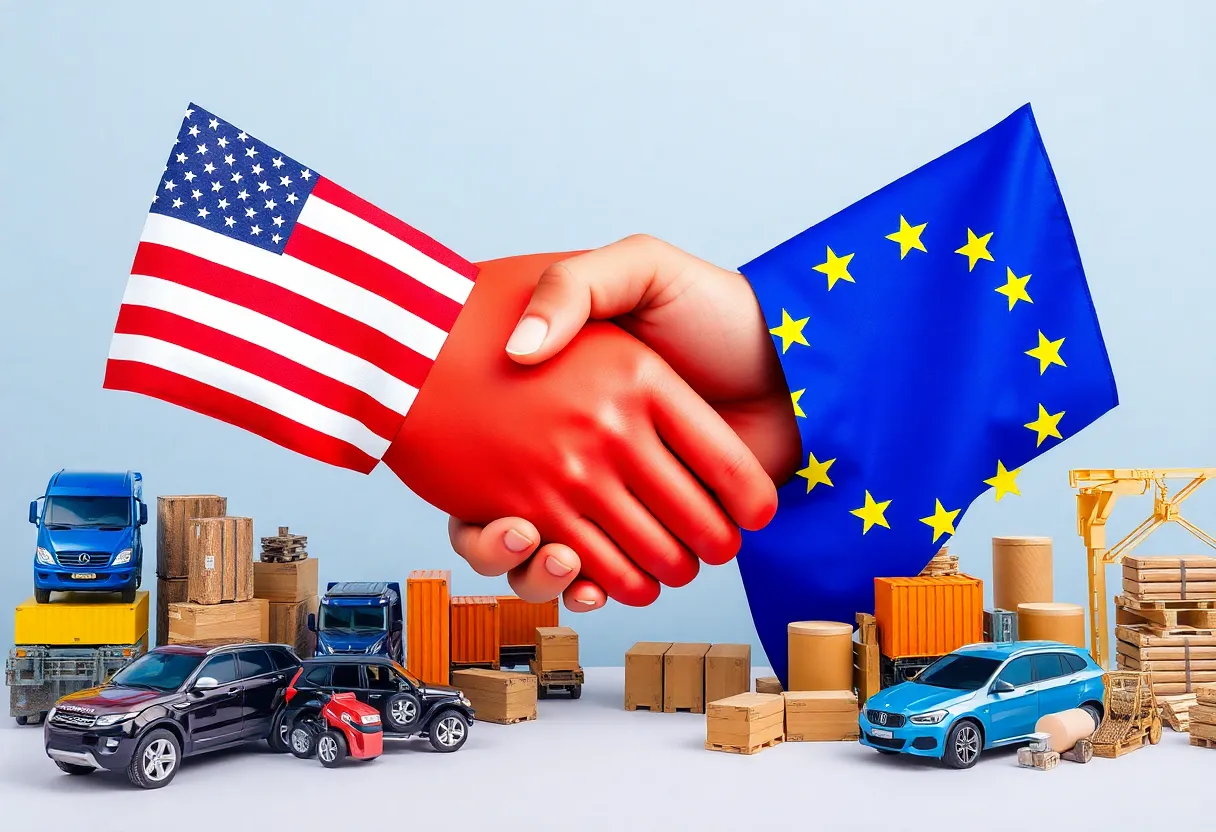News Summary
The trade agreement between the United States and the European Union has been finalized, imposing a 15% tariff on EU exports to the US. While the deal avoids a trade war, it has sparked mixed reactions with many EU leaders expressing disappointment over the terms. The automotive industry is particularly hit hard as tariffs rise significantly. Ongoing negotiations on other tariffs remain uncertain, leaving concerns about the overall impact on EU economies and potential retaliatory measures ahead.
US and EU Make Trade Deal: A Mixed Bag for Europe
The long-anticipated trade agreement between the United States and the European Union was reached this past Sunday, marking a significant shift in trade relations. The new deal will see a 15% tariff imposed on the bulk of EU exports into the US, a move that drastically reduces prior threats of a much higher 30% tax. While many hope this move will help avoid a trade war, the outcome is viewed as a mixed blessing for many European nations.
The Details of the Agreement
This deal allows Washington to not only impose tariffs on EU products but also aims to bolster US exports to Europe. In exchange for this tariff, EU countries are assuring they will purchase upwards of $750 billion in US goods, which includes critical sectors like energy and military equipment.
European Reaction: A Bittersweet Victory
While trade officials in the EU celebrated the avoidance of a potential trade war, many expressed discontent with the terms of the deal. They argued it felt like a concession to US President Trump’s demands. Some leaders featured strong sentiments, dubbing it a “dark day” for European trade, echoing sentiments of disappointment and disillusionment with the agreement’s outcomes.
The Impact on the Automotive Industry
One of the most affected sectors will be the European automotive industry, as the new tariff represents a huge jump from a previous 2.5% rate on car imports. Industry insiders have warned that these tariffs may lead to billions in losses annually, adding to the challenges many manufacturers are already navigating.
Concerns About Future Negotiations
Despite the agreement, there’s still lingering uncertainty in Europe. Trade officials acknowledged that ongoing negotiations regarding specific product tariffs, particularly around wine and spirits, remain unresolved. The current deal imposes a 15% tariff on around 70% of EU goods entering the US, which is a significant increase compared to the average 4.8% tariff rate before the agreement.
Pharmaceuticals and Additional Concerns
Interestingly, pharmaceutical products are spared from immediate tariff hikes due to ongoing national security probes in the US. However, this aspect may not be enough to soothe the anxieties throughout the EU over the intricate implications of this trade agreement.
Regional Responses to Tariffs
Leaders from various EU nations have raised alarms over the economics of the situation. For example, Ireland’s Prime Minister noted higher costs of trade entering into the US market and warned of challenges that Irish exporters will likely face as a result. Some EU officials called for further negotiations to address sectors like wine, steel, and aluminum, highlighting the need for guarantees that were notably absent from the deal.
The Road Ahead
With the understanding that the deal may favor US interests, speculation around potential retaliatory measures from European nations has begun to surface. French officials have described the agreement as “unbalanced,” stressing the importance of asserting European interests rather than yielding to US pressures.
The Final Steps
Before anything can be lifted off the ground, the agreement must be approved by all 27 EU member states. The negotiations, described as “very difficult” by involved authorities, ultimately concluded with a compromise designed to avoid escalating tariffs further.
Market Reactions
When the deal was first announced, it brought a brief surge in European stock markets, but that initial excitement quickly evaporated as more details came to light. Analysts are cautious, warning that this new agreement might just strengthen the competitive edge of the US in trade.
Many European leaders expressed mixed feelings over the announcement—relief for sidestepping a larger trade crisis, but criticism regarding the lackluster terms. As both sides navigate the impacts of this new trade framework, the journey does not end here, and the ripples will likely be felt for some time.
Deeper Dive: News & Info About This Topic
- Washington Post: Trump-EU Trade Tariffs and Concessions
- Wikipedia: Trade Agreement
- DW: EU-US Trade Deal
- Google Search: EU-US Trade Deal
- The Guardian: US-EU Trade Deal Analysis
- BBC News: Analysis of the EU-US Trade Deal

Author: STAFF HERE FLORENCE WRITER
The FLORENCE STAFF WRITER represents the experienced team at HEREFlorence.com, your go-to source for actionable local news and information in Florence, Florence County, and beyond. Specializing in "news you can use," we cover essential topics like product reviews for personal and business needs, local business directories, politics, real estate trends, neighborhood insights, and state news affecting the area—with deep expertise drawn from years of dedicated reporting and strong community input, including local press releases and business updates. We deliver top reporting on high-value events such as the Florence Festival of Lights, Pee Dee Pride, and agricultural expos at the Florence Center. Our coverage extends to key organizations like the Florence Regional Chamber of Commerce and the Pee Dee Area Council of Governments, plus leading businesses in healthcare and retail that power the local economy such as McLeod Health and Pee Dee Electric Cooperative. As part of the broader HERE network, including HERECharleston.com, HEREColumbia.com, HEREGreenville.com, and HEREHiltonHead.com, we provide comprehensive, credible insights into South Carolina's dynamic landscape.





